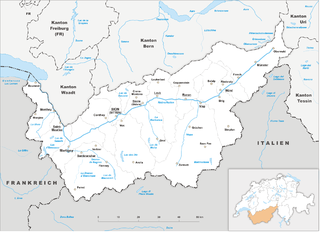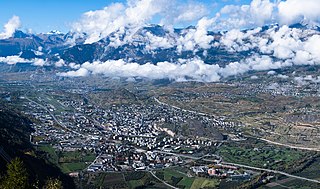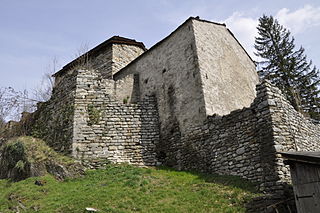
Valais ,,(German; Wallis) more formally the Canton of Valais/Canton of Wallis is one of the 26 cantons forming the Swiss Confederation. It is composed of thirteen districts and its capital and largest city is Sion. The flag of the canton is made of thirteen stars representing the districts, on a white-red background.

Sion is a Swiss town, a municipality, and the capital of the canton of Valais and of the district of Sion. As of December 2020 it had a population of 34,978.

The Battle on the Planta, fought on 13 November 1475 around Conthey near Sion, Valais, Switzerland, was part of the Burgundian Wars.

The Diocese of Sion is a Latin Catholic ecclesiastical territory in the canton of Valais, Switzerland. It is the oldest bishopric in the country and one of the oldest north of the Alps. The history of the Bishops of Sion, of the Abbey of St. Maurice of Valais as a whole are inextricably intertwined.

Matthäus Schiner was a bishop of Sion, Cardinal and diplomat. He was a military commander in several battles in northern Italy.

The Catholic Church in Switzerland is organised into six dioceses and two territorial abbeys, comprising approximately 2.9 million Catholics, about 33.8% of the Swiss population in 2021.

Tourbillon Castle is a castle in Sion in the canton of Valais in Switzerland. It is situated on a hill and faces the Basilique de Valère, located on the opposite hill.

The Valère Basilica, also called Valère castle, is a fortified church situated in Sion in the canton of Valais in Switzerland. It is situated on a hill and faces the Château de Tourbillon, located on the opposite hill. It is a Swiss heritage site of national significance.

Saint-Amé is a commune in the Vosges department in Grand Est in northeastern France.

Norbert Brunner was the bishop of the Roman Catholic Diocese of Sion, Switzerland from 1995 to 2014. He was the elected President of the Swiss Bishops Conference for the term 2010–2012.

Majorie Castle is a castle in the municipality of Sion in the Canton of Valais, Switzerland. It is a Swiss heritage site of national significance.

The Swiss Bishops' Conference is the coordinating body of the Catholic dioceses in Switzerland. It was founded in 1863 as the world's first Bishops Conference and is a member of the Council of European Bishops' Conferences.

The Republic of the Seven Tithings was a state in what is now the Swiss canton of Valais during the early modern period, and an associate of the Old Swiss Confederacy.

Supersaxo is the surname of a number of unrelated families of the Upper Valais. It is a latinized locational surname, from Latin super "above" and saxo (ablative) "rock"; as such it is a direct translation of German auf der Fluh

Joseph Anton Blatter was a Swiss prelate and the 73rd and last Prince-bishop of the Diocese of Sion, in the Republic of the Seven Tithings, in the modern Canton of Valais, from 1790 to 1799, and after the French invasion and dissolution of the republic, Bishop of Sion until his death in 1807.

The ruins of the Gestelnburg castle are situated above the village of Niedergesteln in Valais, Switzerland, on a rocky ridge called Feschti. The castle was probably built during the 12th century by the powerful Barons de la Tour, which are also called in German Herrn vom Turn. The rule of this family ended during the wars against the bishop of Sion in the second half of the 14th century, and the castle was finally destroyed by the Upper Valaisans in 1384. Exactly 600 years later, a project was started to restore the ruins and make them more easily accessible. Behind the castle there is a cave called Feschtiloch, which originates from the last ice age. The Gestelnburg is a Swiss cultural property of national importance.

Chalais Castle is a ruined castle in the municipality of Chalais of the Canton of Valais in Switzerland.

Saillon Castle or Bayard Tower is a ruined castle in the municipality of Saillon of the Canton of Valais in Switzerland. It is a Swiss heritage site of national significance.



















